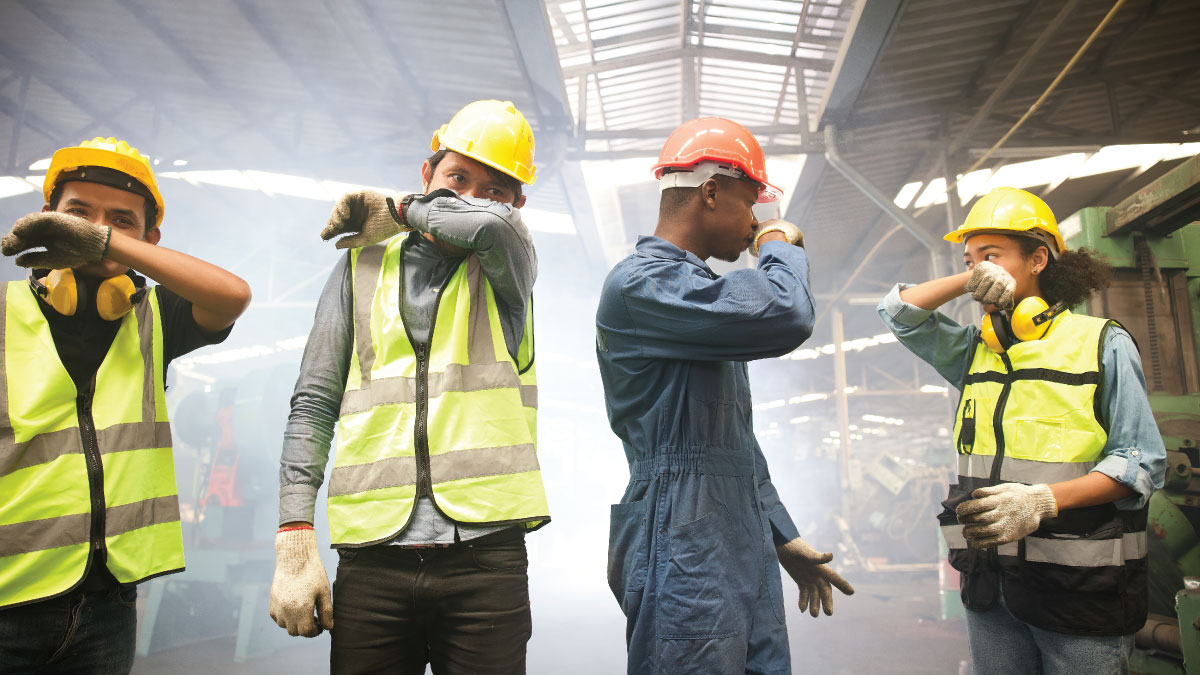By Henrique Pacini and Kweku Attafuah-Wadee, UNCTAD Economists
Workers in a smoke-filled factory. © Mangkorn Danggura
Improving productive capacities is essential to economic diversification, value-addition, and by consequence, social progress. This is especially relevant in the context of regional integration, where production scales grow beyond national markets.
At the same time, industrialization raises the issue of pollution, a multidimensional problem.
Much of the pollution problem relates to exports. For example, large textile clusters in countries like Bangladesh, Kenya, Pakistan and Tanzania exported $79 billion worth of goods in 2019.
To produce those exports, the environmental footprint up to the factory gate involved intense water consumption (44%), land use (19%) and degradation of freshwater quality.
At the manufacturing stage, the largest share of pollution (44%) occurs in the form of soil toxicity, which is hard and expensive to remediate. As a result, gains from manufacturing and trade could be offset by the costs of associated pollution and its toll on human health.
This has ignited concerns over the consequences of trade on the environment, beyond climate change impacts. The manufacturing-pollution-export nexus has received little examination.
Insights from sub-Saharan Africa and South Asia
Balancing green industrial policies with deepening trade integration requires the adoption of clean production technologies.
Positive incentives, such as facilitated transfer of environmentally friendly technologies and technical skills, would be ideal for laying strong foundations across sub-Saharan Africa and South Asia to mitigate manufacturing pollution.
Such technological transfers can make local production processes more efficient by, for example, reducing energy and water use, and avoiding leakages of environmentally harmful substances.
Harnessing life cycle assessments
Furthermore, policymakers in the South should consider harnessing the potential of life cycle assessments (LCAs), as explored by a recent UNCTAD report.
As an example, an analysis by UNCTAD and Instituto 17 shows that for every tonne of palm oil processed for exports in Kenya, 1.8 tonnes of pollutants equivalent to dichlorobenzene are left in the environment, straining local soils.
Insights from LCAs show the manufacturing stage of value addition (gate-to-gate) as contributing to ozone formation and various types of ecotoxicities.
Expanding LCA boundaries to consider upstream factors such as agricultural inputs reveals that export-oriented manufacturing has a significant impact on water consumption and quality, as well as on land-use change.
LCA methods allow a better understanding of the environmental burdens linked to exports. They also help identify the value chain components that are most sensitive in terms of environmental and health impacts.
This information helps local governments better define target sectors for implementing pollution prevention strategies.
Lessons from LCA analyses remind us that industries based on renewable inputs, such as textiles or food and beverages, can have pollution impacts beyond CO2, with equally harmful social consequences.
Unlocking opportunities in manufacturing pollution
Trends in the investment community are helping reduce pollution in manufacturing. These include greening of investment portfolios, usually driven by shareholders, and impact investing related to environmental concerns.
Regulations also influence investors’ actions, such as the European Union Taxonomy on Sustainable Finance, which creates disclosure obligations for companies and financial entities, as well as a common language for investors in projects with substantial impact on the environment.
Through this policy, every fund that flows into an investment, directly or indirectly, from a financial institution based in the European Union will need to comply with the taxonomy.
This European Union initiative promotes a life cycle perspective for investments across the entire value chain (including those based in the south) and champions the best available technologies.
It’s also being used as a best practice in other markets, receiving technical contributions from the United Nations Principles for Responsible Investment.
Recommendations on reducing pollution
Reducing pollution and realizing the full development gains linked to exports would benefit all. Here are some recommendations on doing so:
- The creation of comprehensive trade databases and country-specific LCA inventories for developing countries. This follows recommendations from a recent report coordinated by UNCTAD as part of the Sustainable Manufacturing and Environmental Pollution (SMEP) programme, to better support national governments in decision-making.
- Identification of public and private initiatives to address the manufacturing-pollution-export nexus in the global South. Many environmental governance initiatives from private, public and international actors are gaining traction in Africa and South Asia, such as green manufacturing guidelines, eco-industrial parks, industrial symbiosis, Environmental Management System (EMS) certification, cleaner production, and circular economy practices. They are also proposed by specialized agencies such as UNIDO.
- Better enforcement of environmental legislation designed for manufacturing sectors, where business non-compliance is widespread. This occurs due to various factors, such as high implementation costs, limited access to monitoring systems and weak institutions.
Other practical recommendations include incorporating environmental provisions in regional and bilateral trade agreements, strengthening institutional capacities in terms of training and creating private sector awareness regarding green manufacturing guidelines and their associated opportunities.
This commentary is based on a roundtable discussion held on 7 December 2021 on the role of exports in manufacturing pollution in developing countries. The views expressed are those of the authors.

